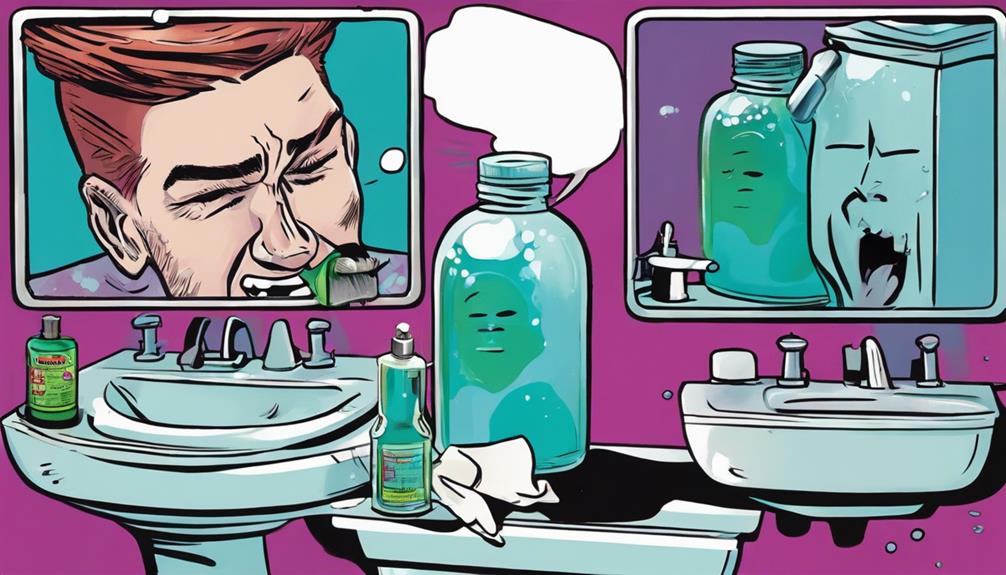To spot early signs of gum disease, watch for red, swollen gums that bleed when you brush or floss. These symptoms often indicate gingivitis, which can escalate if ignored. Persistent bad breath might also signal an underlying issue. Regular dental check-ups are essential for catching these signs early. Pay attention to how your gums feel; tenderness can be a warning. Risk factors like poor oral hygiene, smoking, and hormonal changes increase your vulnerability. By recognizing these symptoms promptly, you can take action to maintain your gum health and prevent complications that could arise. There's more to uncover about prevention and treatment. If you notice any of these early signs of gum disease, it’s important to schedule an appointment with your dentist as soon as possible. They can provide a thorough assessment and recommend the appropriate treatment to address the issue. In addition to professional care, practicing good oral hygiene at home, including brushing and flossing regularly, can help prevent gum disease from developing or worsening. Don’t ignore the early signs of gum disease – taking proactive steps can significantly impact your oral health in the long run.
Key Takeaways
- Look for red, swollen gums, which can indicate inflammation and early signs of gingivitis.
- Monitor for bleeding during brushing or flossing, as consistent bleeding is a major warning sign.
- Be aware of persistent bad breath, which often points to underlying gum disease.
- Regular dental check-ups are crucial for early detection of plaque buildup and gum health assessment.
Understanding Gum Disease

Gum disease, or periodontal disease, starts with gingivitis, which causes your gums to become inflamed and bleed due to plaque buildup. If you notice early signs like swollen or red gums, it's important to take action. Ignoring these symptoms can lead to more severe issues, including periodontitis, where the infection spreads deeper into the supporting structures of your teeth.
Several risk factors contribute to the development of gum disease. Poor oral hygiene is a major culprit, so maintaining a consistent brushing and flossing routine is critical. Smoking and hormonal changes can also increase your likelihood of developing gum disease. Additionally, certain medical conditions like diabetes can exacerbate the problem, making it important to manage your overall health.
Regular dental check-ups play a key role in preventing gum disease. These visits allow your dentist to detect early symptoms and provide necessary interventions before the condition worsens. By staying proactive about your oral hygiene and addressing any issues promptly, you can greatly reduce your risk of developing gum disease and its complications, ensuring a healthier smile for years to come.
Early Symptoms to Watch For

When you notice red, swollen gums that bleed while brushing, it's time to pay attention.
Persistent bad breath can also signal the presence of bacteria, hinting at early gum issues.
Keeping an eye on these symptoms can help you catch gum disease before it progresses.
Red, Swollen Gums
Often, red, swollen gums signal the first signs of gum disease, indicating inflammation from plaque buildup. Healthy gums should appear pale pink and firm, so if you notice redness and swelling, it's important to take action. These symptoms often point to gingivitis, an early form of gum disease affecting nearly 50% of adults over 30.
You might also experience bad breath or tenderness alongside the redness, which emphasizes the need for prompt dental evaluation. Ignoring these signs can lead to more severe issues, so don't wait to address them. Regular dental checkups are fundamental for detecting early signs of gum disease, allowing for early intervention that can potentially reverse gingivitis.
If you notice any changes in your gum color or consistency, it's a strong indication to be proactive. The goal is to maintain healthy gums, which are essential for overall oral health. Remember, the earlier you identify these symptoms, the better your chances of preventing further complications.
Prioritize your dental health, and don't hesitate to consult your dentist if you see red, swollen gums.
Bleeding During Brushing
Bleeding during brushing is a key early warning sign of gum disease that shouldn't be ignored. If you notice bleeding gums consistently while brushing or flossing, it could indicate gingivitis, the initial stage of periodontal disease. This inflammation often stems from plaque buildup, and it's essential to address it early to prevent further complications.
Ignoring this symptom can lead to the progression of gum disease, increasing your risk of tooth loss and other health issues. Regularly monitoring your oral hygiene is important; if bleeding persists, it's time to consult a dental professional. They'll evaluate your condition and guide you on proper care to reverse gingivitis.
The American Dental Association highlights that nearly 50% of adults over 30 experience some form of gum disease, making awareness of these early signs crucial. By taking prompt action, you can maintain your oral health and avoid severe consequences down the line.
Don't wait for symptoms to worsen—recognizing bleeding gums as a warning sign will empower you to take control of your dental health. Prioritize your oral hygiene routine, and don't hesitate to seek professional help when needed.
Persistent Bad Breath
Persistent bad breath, or halitosis, can signal the onset of gum disease, primarily due to bacteria thriving on plaque and tartar in your mouth. If you notice persistent bad breath, it's vital to pay attention, as nearly 85% of individuals with chronic bad breath have an underlying dental condition like gum disease. This condition often worsens after eating, especially with sugary or refined carbohydrate-laden foods that promote bacterial growth.
Alongside persistent bad breath, keep an eye out for other symptoms such as bleeding gums or swollen gums. These signs may indicate the progression from gingivitis to more severe periodontal disease. If you experience these symptoms, don't wait—seek a dental evaluation promptly.
Maintaining good oral hygiene is important in managing bad breath and preventing gum disease. Regular brushing and flossing, combined with routine dental check-ups, can help control plaque and tartar buildup. By staying vigilant and proactive about your oral health, you can reduce the risk of gum disease and its related complications.
Causes of Gum Disease

Gum disease often starts with plaque buildup on your teeth, which can lead to serious issues if you skip regular cleaning.
Hormonal changes and lifestyle factors, like smoking, can also heighten your risk.
Understanding these causes is key to maintaining healthy gums and preventing disease.
Plaque Buildup Impact
One major factor contributing to gum disease is plaque buildup, which forms from food particles and bacteria irritating your gum tissue. If you don't remove this plaque through proper oral hygiene, it hardens into tartar, a substance that can only be cleaned by a dentist or dental hygienist.
Ignoring plaque buildup can lead to gingivitis, the first stage of gum disease, affecting nearly 50% of adults over 30.
To maintain your oral health, it's essential to brush your teeth at least twice a day and floss daily. These practices help eliminate plaque before it hardens, preventing the onset of gum disease.
Regular dental checkups are equally important, as they allow professionals to spot early signs of plaque buildup and assess your gum tissue's health.
Hormonal Changes Role
Hormonal changes during key life stages can markedly impact your gum health, making you more vulnerable to gum disease. For women, these changes often occur during puberty, menstruation, pregnancy, and menopause, leading to increased gum sensitivity.
During pregnancy, elevated hormone levels boost blood flow to your gums, causing swelling and tenderness, which can result in pregnancy gingivitis. Research shows that nearly 50% of women experience some form of gingivitis during this time due to these hormonal changes.
In menopause, hormonal fluctuations may lead to dry mouth and heightened inflammation in gum tissue, increasing your risk of periodontal disease. Additionally, hormonal changes can alter your immune response, making it harder for your body to fend off bacteria that cause gum disease. As a result, you might notice more pronounced symptoms, such as bleeding gums or persistent bad breath.
Being aware of these hormonal effects can help you take proactive measures to maintain your gum health. Regular dental check-ups and good oral hygiene practices are essential during these stages to combat the increased risk of gum disease.
Lifestyle Risk Factors
Your daily habits play a crucial role in either protecting or jeopardizing your gum health, with poor oral hygiene being a primary contributor to gum disease. Infrequent brushing and flossing lead to plaque accumulation, which can trigger inflammation and infection in your gums.
Smoking is another major risk factor; smokers are twice as likely to develop gum disease compared to non-smokers. If you smoke, consider quitting to greatly lower your risk.
Hormonal changes can also affect your gum health. During pregnancy, puberty, and menopause, your gums may become more sensitive, increasing your susceptibility to gum disease.
Certain medical conditions, like diabetes and autoimmune diseases, can exacerbate issues and complicate treatment. If you have any of these conditions, it's essential to maintain excellent oral hygiene to prevent complications.
Lastly, medications that cause dry mouth can leave your gums vulnerable. Reduced saliva flow fails to wash away food particles and bacteria, heightening your risk for gum disease.
Risk Factors Involved

Several key risk factors contribute to the development of gum disease, making it essential to understand what increases your susceptibility. Awareness of these factors can help you take proactive steps to maintain your oral health and prevent complications.
- Smoking: This habit doubles your risk of developing periodontal disease, and the longer you smoke, the greater your susceptibility.
- Hormonal changes: Events like pregnancy or menopause can increase gum sensitivity and make you more prone to gum disease.
- Chronic diseases: Conditions such as diabetes and autoimmune diseases can exacerbate gum disease and negatively impact treatment outcomes.
- Family history: If gum disease runs in your family, you may have a genetic predisposition that elevates your risk.
Importance of Early Detection

Recognizing the early signs of gum disease is vital for maintaining ideal oral health and preventing more severe complications down the line. Early detection can help you catch symptoms like swollen or bleeding gums and persistent bad breath before they escalate into more serious conditions like gingivitis or periodontitis.
Regular dental check-ups play an essential role in this process. By visiting your dentist at least once a year, you increase your chances of identifying gum disease in its infancy, allowing for effective treatment that can prevent tooth loss and bone loss.
Here's a quick overview of why early detection is so important:
| Aspect | Details |
|---|---|
| Gum Disease Types | Gingivitis can progress to periodontitis |
| Risks | Untreated gum disease may lead to systemic health issues |
| Benefits of Early Treatment | Improves oral health and reduces overall health risks |
Diagnosis by Dental Professionals

Dental professionals play a key role in diagnosing gum disease through thorough examinations that identify early warning signs like swollen or bleeding gums. During your dental check-ups, they'll assess your oral health and look for symptoms of gingivitis or more advanced periodontal disease. They often utilize periodontal probes to measure the depth of gum pockets, which helps evaluate the extent of any gum disease present.
Key aspects of the diagnosis process include:
- Evaluating plaque buildup to identify early signs of gum disease
- Using X-rays to detect bone loss around teeth
- Classifying severity with the Community Periodontal Index (CPI)
- Monitoring for symptoms like persistent bleeding gums
Treatment Options Available

Effective treatment options for gum disease include professional dental cleanings, scaling and root planing, and advanced surgical procedures, all aimed at restoring your oral health.
Initially, your dentist will likely recommend professional dental cleanings to remove plaque and tartar, which are vital for reversing early-stage gingivitis. If your gum disease has progressed, scaling and root planing may be necessary. This procedure involves cleaning below the gum line and smoothing tooth surfaces to reduce bacteria.
For more severe cases, advanced treatment options like gum grafting or bone grafting may be required to restore damaged tissues and structures supporting your teeth. In addition, your dentist might prescribe antimicrobial mouthwashes and other prescription treatments to help control infection and reduce bacterial levels.
Continuous monitoring and follow-up visits are important to evaluate the effectiveness of your treatment plan. Regular check-ups—ideally every six months or more frequently if you have gum disease—help maintain your oral health and guarantee that any issues are addressed promptly.
Preventive Measures to Consider

To keep gum disease at bay, adopting preventive measures is just as important as seeking treatment when issues arise. Maintaining good oral hygiene can greatly reduce your risk of developing gum disease and its common symptoms. Here are some essential steps you should consider:
- Brush and floss daily: Brush twice a day with fluoride toothpaste and floss at least once to remove plaque and food particles effectively.
- Schedule regular dental cleanings: Visit your dentist at least twice a year for professional cleanings to eliminate tartar and bacteria that can lead to gum recession.
- Watch for early signs of gum disease: Stay alert to symptoms like bleeding gums or persistent bad breath, as catching these early can prevent serious issues.
- Use antibacterial mouthwash: Incorporate an antibacterial mouthwash into your routine to help reduce plaque and combat gingivitis.
Frequently Asked Questions
How Do You Tell if You Have Early Gum Disease?
You can tell if you have early gum disease by noticing red, swollen gums that bleed when you brush. Persistent bad breath, tenderness, and gum recession are also signs to watch for. Regular dental visits help too.
What Is the Early Onset of Gum Disease?
The early onset of gum disease, or gingivitis, shows up as swollen, red gums that bleed when you brush. If you notice persistent bad breath or tenderness, it's time to seek dental advice.
What Does the Start of a Gum Infection Look Like?
When it comes to gum infections, you might notice swollen, red gums that bleed easily. Persistent bad breath or receding gums could also be early indicators, signaling that you need to take action before it worsens.
How Can I Check My Gum Disease at Home?
You can check for gum disease at home by examining your gums for redness, swelling, and bleeding. Look for bad breath, sensitivity, and any deep pockets between your teeth. Regular checks can keep your gums healthy.
Are Early Signs of Gum Disease Often Misdiagnosed or Overlooked by Dentists?
Many people wonder if early signs of gum disease are often misdiagnosed or overlooked by dentists. According to recent studies, there is a concern that some dentists may overlook the early signs of gum disease to profit from unnecessary treatments. The issue of dentist pricing scams revealed is a serious one that patients need to be aware of.
Conclusion
Spotting the early signs of gum disease can mean the difference between a simple fix and extensive dental work.
Ignoring those subtle symptoms might lead you down a path of pain and costly treatments, while taking action early can preserve your smile and overall health.
By staying vigilant and proactive, you can safeguard your gums and enjoy a confident, pain-free life.
Remember, a little attention today can save you from a lot of trouble tomorrow!









